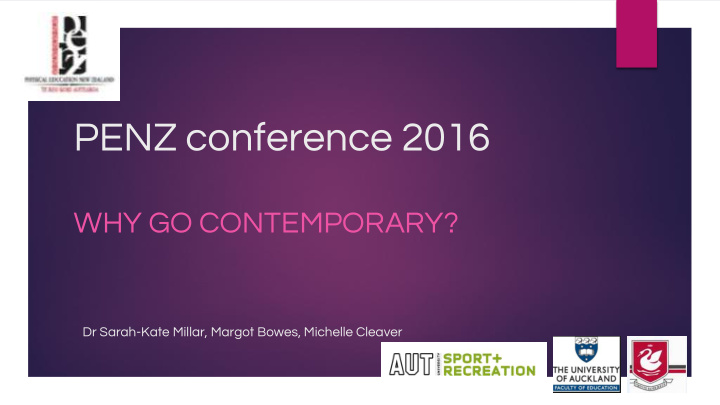



PENZ conference 2016 WHY GO CONTEMPORARY? Dr Sarah-Kate Millar, Margot Bowes, Michelle Cleaver
Why? ● Mismatch between practice and theory ● Reading the Physical Educator Volume 47/3 November 2014 made WGHS curious . : (Skill Acquistion for Senior School Physical Education: Up ‘skilling’ for the 21st Century – Margot Bowes) ● Feeling we were not adding value to the student learning from Level 2 ● An authentic and practical way to view skill acquisition from a critical lens ● Read ‘Dynamics of skill acquistion ‘ and starting a team inquiry into the knowledge ● Verity Sharland and I were very lucky to be able to work closely with Skate at AUT
Some Background Theory PERCEPTION How do we learn movement skills? ● Ecological Psychology and Perception - Action Coupling ● Practice: The Environment is key ACTION
Key Point ● Individual Differences mean that there is no such thing as: “THE PERFECT MOVEMENT TEMPLATE” ● Meaning: Repetitive drills DO NOT lead to expert performances (BUT might be good for confidence)
Key Principles of Dynamical Systems Theory: ● Self Organisation ● Attractor Patterns ● Constraints-led approach
Practical time ! Let’s engage with the theory - Play time !!
Self Organisation ● By a process of exploration a student/athlete will self organise in order to achieve the task goal. Body Fits the skill ● Discovery Learning ● Inner Game Learning ● The nature of the instructions about the task goal are vital
Attractor Patterns ● How do we develop movement patterns? Individual biomechanical efficiency ● Movement patterns are loosely assembled…co -ordinative structures under constraints (Williams & Davids, 1999). ● Therefore Skilled performers are: – Adaptable and demonstrate functional variability
Constraints ● Constraints are influential factors within the practice environment… Individual ● Constraints are not necessarily negative influences on behaviour, but exemplify the way that movement system components are integrated to form specific types of functional organization (Chow, Davids, Button, Task Environment Shuttleworth, Renshaw & Aurajo et al, 2006). SKILL LEARNING
A Con onstra traint ints-Le Led d Pe Perspe pective ctive
Summary ● Skilled movements (or attractor patterns) EMERGE based on the individual, environmental and task constraints at any specific moment in time. ● People will SELF ORGANISE if they are given the chance to do so.
How? ● Students followed two skill acquisition programmes. One used a traditional approach to skill acquisition and the other took a contemporary or Constraints-Led approach. ● Students completed reflections after each session ● Final assessment task for AS3.3 had questions that led them to compare and contrast between the two approaches
What did we observe? Experience? ● Excited us as teachers to be doing something different, trying new approaches ● The content sat well with our teaching around thinking critically about ‘one size fits all’ approaches and the ‘supposed perfect technique’ (Critical evaluation in 3.2 and 3.3) Students engaged with the theory once they experienced it in a practical sense ● ● It allowed for authentic critical evaluation when comparing and contrasting between approaches. In the past answers have seemed somewhat forced in nature when comparing and contrasting between ‘types of practice’ for example
Where to from here? : Level 3 Most of our focus (and understanding!) initially was on manipulation of task constraints ● and this was easy to put into a practical setting. This year we placed more emphasis on the Perception – Action coupling knowledge. ● We will go further with this next year. ● Change the reflection questions to guide on deeper thinking around coupling and self - organisation We are developing confidence in creating activities that we think encourage performers ● to cope with variable environmental conditions We are still unsure as to how much/when/or if any actual ‘instruction’ and feedback ● would or should be given on things such as technique
Conceptual Visualisation of skill acquisition Jigsaw time !!
Lets go Contemporary E.G. Year and The curriculum Linked to The following language is Traditional Contemporary Level suggests students Achievement used in Achievement approaches to skill approaches to skill should be able to... Standard Standard acquisition acquisition B1 Acquire, apply, and Yr 11, 1.6 (Demonstrate Use principles of motor skill refine specialised Level strategies to improve learning to acquire, apply and · Frequently · Movement motor skills by using 6-7 the performance of a refine practice teacher directed variability the principles of motor physical activity and Quality of practice, type of (e.g. Gymnastics or · Self skill learning. describe the outcomes) practice, amount of practice, street ball) with organisation (Also B3) tactics and strategies, levels specific activities set · Attractor of related fitness, level of to enable patterns motivation, goal setting performance · Coordinated movement · Learning = retention and transfer
Question and Answer time
Resources Great article to read: Renshaw, I., Davids, K., Shuttleworth, R., & Chow, J. (2009). Insights from Ecological Psychology and Dynamical Systems. Theory Can Underpin a Philosophy of Coaching. International Journal of Sport Psychology, 40 (4), 580-602. Available to download online - QUT University
Contacts Dr Sarah-Kate Millar : skmillar@aut.ac.nz Margot Bowes: m.bowes@auckland.ac.nz Michelle Cleaver: mcleaver@westlakegirls.school.nz
Recommend
More recommend